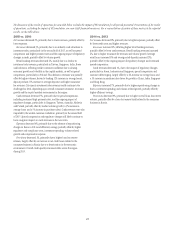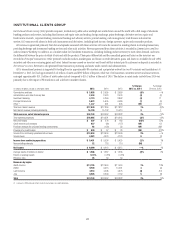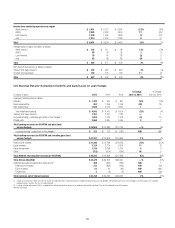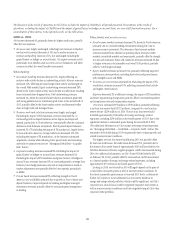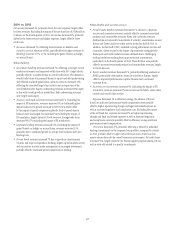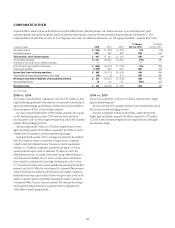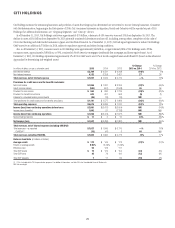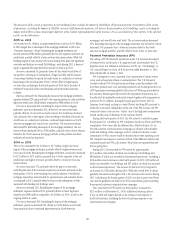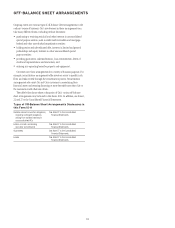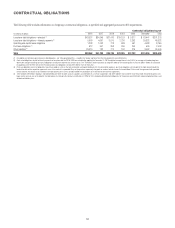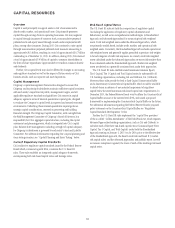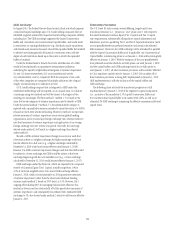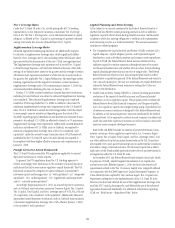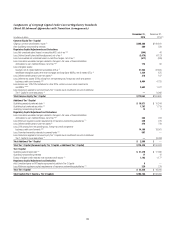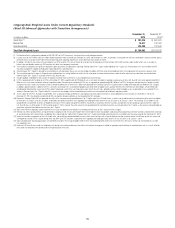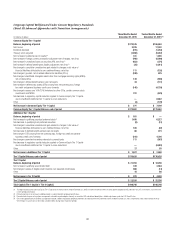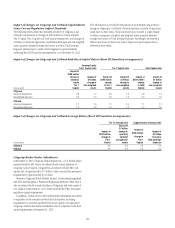Citibank 2015 Annual Report Download - page 51
Download and view the complete annual report
Please find page 51 of the 2015 Citibank annual report below. You can navigate through the pages in the report by either clicking on the pages listed below, or by using the keyword search tool below to find specific information within the annual report.33
CAPITAL RESOURCES
Overview
Capital is used principally to support assets in Citi’s businesses and to
absorb credit, market, and operational losses. Citi primarily generates
capital through earnings from its operating businesses. Citi may augment
its capital through issuances of common stock, noncumulative perpetual
preferred stock and equity issued through awards under employee benefit
plans, among other issuances. During 2015, Citi continued to raise capital
through noncumulative perpetual preferred stock issuances amounting to
approximately $6.3 billion, resulting in a total of approximately $16.7 billion
outstanding as of December 31, 2015. In addition, during 2015, Citi returned
a total of approximately $5.9 billion of capital to common shareholders in
the form of share repurchases (approximately 101 million common shares)
and dividends.
Further, Citi’s capital levels may also be affected by changes in accounting
and regulatory standards as well as the impact of future events on Citi’s
business results, such as corporate and asset dispositions.
Capital Management
Citigroup’s capital management framework is designed to ensure that
Citigroup and its principal subsidiaries maintain sufficient capital consistent
with each entity’s respective risk profile, management targets, and all
applicable regulatory standards and guidelines. Citi assesses its capital
adequacy against a series of internal quantitative capital goals, designed
to evaluate the Company’s capital levels in expected and stressed economic
environments. Underlying these internal quantitative capital goals are
strategic capital considerations, centered on preserving and building
financial strength. The Citigroup Capital Committee, with oversight from
the Risk Management Committee of Citigroup’s Board of Directors, has
responsibility for Citi’s aggregate capital structure, including the capital
assessment and planning process, which is integrated into Citi’s capital
plan. Balance sheet management, including oversight of capital adequacy,
for Citigroup’s subsidiaries is governed by each entity’s Asset and Liability
Committee. For additional information regarding Citi’s capital planning and
stress testing exercises, see “Capital Planning and Stress Testing” below.
Current Regulatory Capital Standards
Citi is subject to regulatory capital standards issued by the Federal Reserve
Board which, commencing with 2014, constitute the U.S. Basel III
rules. These rules establish an integrated capital adequacy framework,
encompassing both risk-based capital ratios and leverage ratios.
Risk-Based Capital Ratios
The U.S. Basel III rules set forth the composition of regulatory capital
(including the application of regulatory capital adjustments and
deductions), as well as two comprehensive methodologies (a Standardized
Approach and Advanced Approaches) for measuring total risk-weighted
assets. Total risk-weighted assets under the Advanced Approaches, which
are primarily models based, include credit, market, and operational risk-
weighted assets. Conversely, the Standardized Approach excludes operational
risk-weighted assets and generally applies prescribed supervisory risk weights
to broad categories of credit risk exposures. As a result, credit risk-weighted
assets calculated under the Advanced Approaches are more risk sensitive than
those calculated under the Standardized Approach. Market risk-weighted
assets are derived on a generally consistent basis under both approaches.
The U.S. Basel III rules establish stated minimum Common Equity
Tier 1 Capital, Tier 1 Capital and Total Capital ratios for substantially all
U.S. banking organizations, including Citi and Citibank, N.A. (Citibank).
Moreover, these rules provide for both a fixed Capital Conservation Buffer
and a discretionary Countercyclical Capital Buffer, which would be available
to absorb losses in advance of any potential impairment of regulatory
capital below the stated minimum risk-based capital ratio requirements. In
December 2015, the Federal Reserve Board voted to affirm the Countercyclical
Capital Buffer amount at the current level of 0%, and issued a proposed
framework for implementing the Countercyclical Capital Buffer in the future.
For additional information regarding the Federal Reserve Board’s proposed
policy statement on the Countercyclical Capital Buffer, see “Regulatory
Capital Standards Developments” below.
Further, the U.S. Basel III rules implement the “capital floor provision”
of the so-called “Collins Amendment” of the Dodd-Frank Act, which requires
Advanced Approaches banking organizations, such as Citi and Citibank, to
calculate each of the three risk-based capital ratios (Common Equity Tier 1
Capital, Tier 1 Capital, and Total Capital) under both the Standardized
Approach starting on January 1, 2015 (or, for 2014, prior to the effective date
of the Standardized Approach, the Basel I credit risk and Basel II.5 market
risk capital rules) and the Advanced Approaches and publicly report (as well
as measure compliance against) the lower of each of the resulting risk-based
capital ratios.


